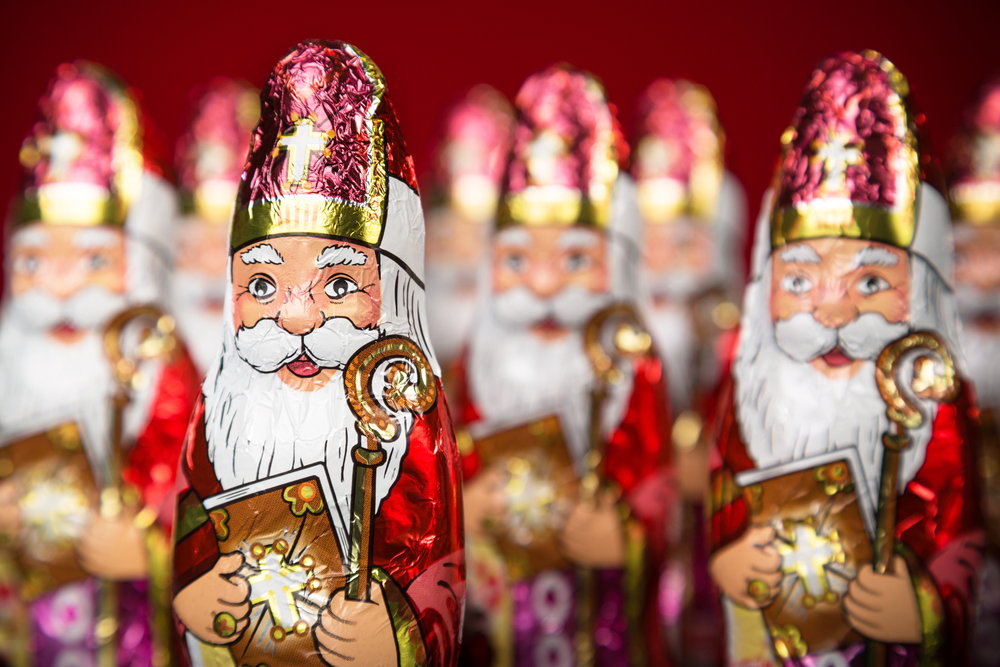As we deck the halls with boughs of holly this year, read the story of Christ’s Nativity, sing hymns and carols, exchange gifts, and light our homes in increasingly irrational competition verging on mutually assured destruction with our neighbors, we must not lose sight of the real “reason for the season”: Santa’s victory over the pagan goddess Artemis.
Really.
Just to be clear, I am aware that Jesus is what Christmas is all about. It’s his birthday, after all, and Christians dated our Lord’s birth from the Virgin Mary to December 25 as a by-product of calculations of the date of his death and resurrection, dating long before the Christianization of ancient Rome. Today, however, like it or not, Santa Claus is just as much a part of the season as Jesus. The good news is that he is real—and a Christian! In particular, he was bishop of Myra in Lycia in Asia Minor in the fourth century. “Santa Claus,” after all, is just a weird, telephone-game distortion of “Saint Nicholas.”
But who was Nicholas? Most people have heard one or both of the following stories. First, there is the story of the gold coins, in which a teenage Nicholas, living under his uncle’s care, learns of a down-on-his luck, aristocratic widower who cannot afford to care for his three daughters, thus facing the terrible alternatives of slavery or prostitution for them as they come of age. Three nights in a row, Nicholas takes gold from his inheritance and wraps it in a handkerchief, tossing enough money to pay for a dowry for each daughter through the man’s open window. The third time, the man stays up and catches Nicholas, thanking him and promising not to reveal the story to anyone until after Nicholas’ death. This story accounts, at least in part, for Santa’s association with gift-giving and children. It is well attested in ancient sources, though of course whether one believes any of the details of Nicholas’ life comes down to faith.
The other well-known story has to do with his attendance at the Council of Nicaea. The majority of the attendance rolls we have include one Nicholas, bishop of Myra. This is probably the best evidence we have of the historical St. Nick. What is less well established, but still well known, is that while the Alexandrian deacon Arias defended his position that the Son of God is of a lesser nature than the Father, Nicholas, moved by zeal, got up and struck him in the face. The emperor, Constantine, had Nicholas bound and removed his bishop’s gear, placing him under house arrest. But in the night, Christ and his Virgin Mother appeared to Nicholas and untied his bonds, returning his stole, miter, and staff. When the guards found him again dressed as a bishop and studying the Gospel in the morning, news of the miracle spread throughout the palace. The emperor then asked his forgiveness and returned him to the council.
One must at least believe in miracles for this version to be a live option, but as the council ultimately determined Arianism to be a heresy, and Nicholas was one of the bishops at the council, even skeptical historians should confidently ascribe to him at least some zeal for theological orthodoxy, as is the point of the story. Furthermore, the doctrinal issue in question was even the Son of God’s Nativity! … just not his Nativity in the flesh. The council affirmed that being begotten of the Father is an act of eternal generation, like how fire always produces heat and light, rather than an act of creation. In short, there never was a time when the Son was not.
So how does paganism, not to mention the goddess Artemis, factor into this? According to tradition, Nicholas was born in AD 270. In 285, Emperor Diocletian came to power. Diocletian sought to stamp out Christianity. His paganism was not benignly indifferent but militant and hostile, and his religiously intolerant policy continued after he abdicated in 305, through the reign of Galerius in the East and until the so-called Edict of Milan in 313, promulgated by Constantine, the first Christian emperor. Thus, Nicholas’ teenage years were spent in a pagan society, one in which poor young women without dowries faced slavery or prostitution. Indeed, while Christian Rome had its faults, young, suitor-less women had at least one better option available to them: joining a monastery.
So Santa’s provision of the dowries was more than charity—it counteracted a social injustice of pagan society. And the Council of Nicaea, of course, would not have taken place under the emperor’s care unless the emperor were a Christian. Indeed, according to all ancient accounts, Constantine merely hosted the council as a layman. The bishops were in charge, marking a massive paradigm shift in the role of the state in religious matters compared with Rome’s pagan past, in which emperors were high priests and often posthumously deified by the Senate and worshipped.
The topic of the council matters, too. Arius’ position ultimately amounts to polytheism. If the Son of God is not equally divine with the Father but instead some sort of lesser, created divinity, then he is no different from Zeus or Poseidon or, well, Artemis, all of whom had different natures and, in the theogonies of paganism, origins. Without the Council of Nicaea, the Christianization of Rome would have meant merely the displacement of one paganism by another.
The cult of Artemis was active in the region of Lycia in Asia Minor up to the mid-fourth century. By all accounts, Nicholas grew up in Lycia, and his uncle was bishop of Myra there before him. According to tradition, Nicholas was even imprisoned, perhaps for more than a decade, during the reigns of Diocletian and Galerius. Scientific examination of his relics shows that at some point in his life he suffered a broken nose that never properly healed. Put simply, Nicholas was no pushover and perhaps even the sort to turn an ecumenical council into a fistfight. In any case, the militant paganism of the region took form in the cult of Artemis.
Artemis, for her part, was goddess of fertility, the harvest, and the hunt. She was patron of women and children, and pagans believed her both to protect them from disease and to inflict it upon them. She was also referred to with the epithets Aetole and Agoraea, indicating that she was regarded as a protectress of the agora, or market, and perhaps also of merchants.
Sometime after Nicaea, there was a famine in Lycia, during which several well-attested events attributed to Nicholas took place. In the story of the coins, we have already seen Nicholas, rather than Artemis, as the true protector of young women (and by extension, fertility and children) for the sake of his faith in Christ and their dignity. In these famine stories, we see further repudiation of the cult of Artemis by Nicholas. None of the woes suffered by the people are attributed to the saint or to Christ. Unlike the goddess, who was as much tormentor as protector, the Christian message of Nicholas was one of the grace of God in our fallen world.
First, sailors aboard a grain ship encounter a storm and pray not as the pagans would to Artemis but rather to Nicholas, whose faith and reputation they have heard of but whom they have not met. He appears to them, bilocating like a Jedi, and calms the storm, steering the ship with supernatural strength. He then asks them to make port in Myra and gives them three gold coins as a deposit for them to sell their grain to the people there.
Another time, several ships pass by on their way from Alexandria to Constantinople. Nicholas calls out to them from the shore, asking them to give grain to the people. They protest that they had weighed their cargo and it could not be found wanting. Nevertheless, at Santa’s assurance, they each give him 100 bushels of grain, which last two whole years and provide planting for a third, saving Lycia from the famine. Miraculously, when the ships arrive in Constantinople, their payloads weigh the same as when they left Alexandria.
Thus, in these stories we see Nicholas directing the people away from Artemis and to Christ, displacing her from her roles as patron of the harvest and the market. Indeed, through the ages Nicholas has been regarded as patron saint of seafarers.
One last story demonstrates Santa’s ultimate victory over Artemis: the destruction of her temple in Myra. Sources are conflicted in the details and exhibit the same reliability as the story of Nick’s slap heard ’round the world at Nicaea. Archeological evidence, however, attests that a temple of Artemis once stood in Myra and that it fell sometime in the fourth century. Traditionally, Nicholas died on December 6, 343, so it may very well have met its demise during his lifetime. It’s important to keep in mind that ancient Christians believed pagan gods to be not just false but demonic—that is, they believed them to be real, malevolent spiritual entities. As St. Paul put it, “The things which the Gentiles sacrifice they sacrifice to demons and not to God” (1 Cor. 10:20). According to one account, Nicholas goes to Artemis’ temple and prays to Christ, the earth shakes, and the temple collapses. By another account, he uproots its foundations with supernatural strength, and demons loyal to Artemis confront him, claiming that they had done nothing wrong in deceiving such foolish humans. Santa, like a modern action hero, merely responds, “Go to hell’s fire,” and walks off into the sunset, the smoldering ruins of Artemis’ temple at his back.
Again, no doubt this stretches modern readers’ credulity. But given the big picture, we can see how this story is emblematic of the larger civilizational and spiritual changes of the time. There are at least some confirmed facts at the bottom of these stories, and these stories, as well as continuing Christian veneration of Nicholas to the present day, memorialize those facts’ greater meaning: Christians should not tolerate social structures and economic circumstances that lead to slavery, prostitution, or starvation. The triumph of Christian theological orthodoxy marks a separate sphere of authority in the Church, one that brought about a great amount of social good in terms of charitable work and canon law. In short, once Christianity became legal in the empire, the people gradually abandoned a pagan worldview, in which human beings are the undignified playthings of fickle fate, and embraced the Christian worldview that human beings are made in God’s image and, in Christ’s words, “inasmuch as you did [good] to one of the least of these My brethren, you did it to Me” (Matt. 25:40).
While it is likely that the proximity of December 6 to Christmas accounts for Santa’s popularity during this season, greater familiarity with traditional stories about the real saint certainly fit with the dawn of a new gospel, not the announcement of a pagan emperor’s military victory (as the term “gospel” had previously been used), but the good news of one born of a virgin who conquered sin, error, and death by his death and resurrection. As one Eastern Christian hymn puts it, referring to the magi, “For by Your birth those who adored stars were taught by a star to worship You, the Sun of Justice, and to know You, Orient from on High.”
True, we do have some funny stories about Santa Claus this time of year, and I, like others, struggle to direct my children to the true meaning of the season. But one thing we do not have to worry about: the goddess Artemis. And we can thank St. Nicholas for that.
Merry Christmas!

